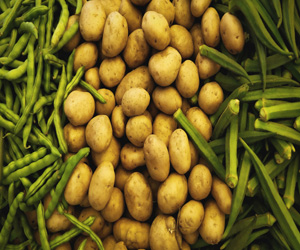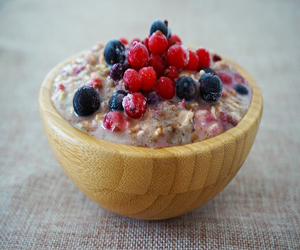


Health And Dietary Considerations

The gluten-free lifestyle has gained immense popularity in recent years, transcending its initial association with medical necessity to become a dietary choice for many. Whether you're one of the millions of people with celiac disease, gluten sensitivity, or simply someone curious about this lifestyle, it's important to understand its implications and benefits.
The Gluten-Free Basics
At its core, a gluten-free lifestyle involves eliminating the consumption of gluten, a protein found in wheat, barley, rye, and their derivatives. This dietary choice is not only essential for those with celiac disease, an autoimmune disorder triggered by gluten, but also for individuals with gluten sensitivity or wheat allergies.
The gluten-free diet requires careful attention to ingredient labels, as gluten can hide in unexpected places. Fortunately, there is an ever-expanding array of gluten-free products on the market, making it easier for those adhering to this lifestyle to enjoy a wide variety of foods.
Health Benefits
For individuals with celiac disease or gluten sensitivity, adopting a gluten-free lifestyle is non-negotiable. Consuming gluten can lead to severe health consequences and discomfort. However, even for those without these conditions, there are potential health benefits to going gluten-free.
Some people report improved digestion, increased energy, and reduced gastrointestinal discomfort when they eliminate gluten from their diets. This could be attributed to the fact that many gluten-containing foods are also highly processed and high in refined carbohydrates. A gluten-free diet can encourage individuals to choose more whole and naturally gluten-free foods like fruits, vegetables, lean proteins, and legumes.
Potential Drawbacks
While the gluten-free lifestyle offers various benefits, it's essential to be mindful of potential drawbacks. A gluten-free diet can be challenging to maintain, as gluten is pervasive in many common foods. Additionally, gluten-free products can be more expensive, and some may lack essential nutrients like fiber and certain vitamins.
Moreover, there is a risk of unintentional cross-contamination, which can occur when gluten-free foods come into contact with gluten-containing foods during preparation. For those with celiac disease, even trace amounts of gluten can be harmful, so maintaining a gluten-free kitchen and dining out at certified gluten-free establishments may be necessary.
Navigating The Gluten-Free Lifestyle
For those considering a gluten-free lifestyle, it's important to do so with informed choices. Consulting a healthcare professional or registered dietitian can provide guidance on maintaining a well-balanced and nutritionally sound diet.
Exploring naturally gluten-free foods like rice, quinoa, and potatoes is a good place to start, along with incorporating gluten-free grains and flours like cornmeal, almond flour, and coconut flour into your cooking and baking. Be vigilant about reading food labels, and when dining out, communicate your dietary needs with restaurant staff to avoid accidental gluten exposure.
The gluten-free lifestyle has evolved from a medical necessity to a popular dietary choice with potential health benefits. For those with celiac disease, gluten sensitivity, or wheat allergies, it's a must. For others, it can be an option to explore. However, as with any diet, informed choices, proper education, and healthcare guidance are vital to ensure a healthy and balanced gluten-free lifestyle.
A Recipe For A Better Tomorrow
 Supporting Local Farmers: By choosing locally sourced products, we bolster the livelihood of farmers in our communities. These farmers often employ sustainable farming practices, which protect the environment while producing high-quality, fresh food. Supporting local agriculture helps to keep family farms in business, preserving the rural way of life and ensuring a reliable source of food close to home.
Supporting Local Farmers: By choosing locally sourced products, we bolster the livelihood of farmers in our communities. These farmers often employ sustainable farming practices, which protect the environment while producing high-quality, fresh food. Supporting local agriculture helps to keep family farms in business, preserving the rural way of life and ensuring a reliable source of food close to home.
Reducing Environmental Footprint: Transporting food over long distances generates a significant carbon footprint. Local and sustainable choices mean that the journey from farm to table is shorter, reducing the environmental impact of our food consumption. Additionally, sustainable farming practices, such as organic farming and regenerative agriculture, minimize the use of harmful chemicals and prioritize soil health, further lessening environmental harm.
Preserving Biodiversity: Local and sustainable agriculture often focuses on heirloom and traditional varieties of crops and livestock. This helps preserve biodiversity, ensuring that unique and heritage breeds and plant varieties continue to thrive. Maintaining a diverse range of species is crucial for resilience in the face of pests, diseases, and changing climate conditions.






 Fresh Ingredients As Key Players
Fresh Ingredients As Key Players
Flavorful plant-based cuisine places a strong emphasis on the use of fresh, seasonal ingredients. Fruits and vegetables in their prime, legumes, whole grains, nuts, and seeds form the foundation of these dishes. The freshness and quality of these ingredients not only enhance the taste but also provide a wealth of nutrients, vitamins, and minerals.
Spices And Herbs For Complexity
Spices and herbs are the secret weapons in crafting flavorful plant-based dishes. Ingredients like garlic, ginger, turmeric, cumin, coriander, and a variety of aromatic herbs are used to create layers of complexity in flavors. These natural seasonings not only add depth but also contribute to the health benefits of the dishes.
Umami-Rich Ingredients
Umami, the fifth basic taste, often associated with savory and meaty flavors, is a hallmark of many plant-based recipes. Ingredients like mushrooms, soy sauce, miso, and nutritional yeast are used to add richness and depth to dishes, giving them a satisfying and meaty taste without actual meat.
Texture And Presentation
Texture plays a significant role in the appeal of flavorful plant-based dishes. Ingredients like tofu, tempeh, seitan, and various plant-based meat substitutes offer the chewiness and mouthfeel traditionally associated with animal products. Expertly prepared, these ingredients can mimic the texture of meat in a way that adds to the overall dining experience.
Nourishing The Spirit With Every Bite
 The beauty of soul-soothing dishes is that they transcend borders and cultures. While the specific recipes may differ, the concept of comforting food is universal. In the United States, it might be a plate of buttery mashed potatoes and gravy. In Japan, it could be a simmering bowl of miso soup. In India, a fragrant pot of dal and rice. The world is filled with these culinary hugs that have been perfected over generations.
The beauty of soul-soothing dishes is that they transcend borders and cultures. While the specific recipes may differ, the concept of comforting food is universal. In the United States, it might be a plate of buttery mashed potatoes and gravy. In Japan, it could be a simmering bowl of miso soup. In India, a fragrant pot of dal and rice. The world is filled with these culinary hugs that have been perfected over generations.
Soul-soothing dishes hold a special place in the hearts of many not only because of their delectable flavors but because they provide a sense of belonging and security. These are the meals that a loved one might prepare when you're feeling under the weather or after a challenging day. The aroma of a soul-soothing dish simmering on the stove is often enough to ease stress and bring comfort.
Moreover, the process of preparing soul-soothing dishes can be a form of therapy in itself. The act of chopping, sautéing, and stirring can be meditative, providing a sense of calm and mindfulness. Creating a comforting dish can be a labor of love, an opportunity to pour your heart into something that will not only satisfy your physical hunger but also nourish your soul.
Essential Tips For Success
 2. Start With Whole Foods
2. Start With Whole Foods
The foundation of a gluten-free lifestyle is natural, unprocessed foods. Fresh fruits and vegetables, lean proteins, and unprocessed grains like rice and quinoa are naturally gluten-free. These foods should form the basis of your diet, providing you with essential nutrients and fiber.
3. Experiment With Gluten-Free Alternatives
There's a wide variety of gluten-free alternatives available for the bread, pasta, and baked goods you love. Try different gluten-free flours, such as rice, almond, and coconut flour, in your recipes. Experiment with gluten-free pasta made from corn, rice, or quinoa. Over time, you'll discover which products and brands you prefer.
4. Beware Of Cross-Contamination
Cross-contamination is a significant concern for people with celiac disease. Even trace amounts of gluten can trigger symptoms or damage the small intestine. To prevent cross-contamination, create a designated gluten-free area in your kitchen.
The Art Of Ingredient Substitutions
 All-Purpose Flour: If you're out of all-purpose flour and need a substitute for baking, you can use alternatives like almond flour, coconut flour, or oat flour, depending on the recipe.
All-Purpose Flour: If you're out of all-purpose flour and need a substitute for baking, you can use alternatives like almond flour, coconut flour, or oat flour, depending on the recipe.
Sugar: For a healthier alternative, you can replace refined sugar with options like honey, maple syrup, or coconut sugar.
Butter: When a recipe calls for butter, you can use alternatives like coconut oil, olive oil, or unsweetened applesauce, depending on the application.
Heavy Cream: To replace heavy cream in savory dishes, you can use ingredients like Greek yogurt, silken tofu, or a mixture of milk and butter. For desserts, coconut cream can be a suitable alternative.
Healthier Ingredient Substitutions
Ingredient substitutions aren't just about convenience; they can also be used to make your dishes healthier. For example:
White Rice: Swap white rice for brown rice, quinoa, or cauliflower rice to increase fiber content and boost nutritional value.
Mayonnaise: In salads and sandwiches, you can replace mayonnaise with Greek yogurt for a lower-fat alternative.
Breadcrumbs: Instead of breadcrumbs, you can use crushed nuts or rolled oats for a gluten-free option in recipes.
Dietary Restrictions And Allergies
Ingredient substitutions are especially crucial for individuals with dietary restrictions and allergies. For those with gluten allergies, there are many gluten-free flours and starches available.
 Hydration And Digestive Health
Hydration And Digestive Health
Staying hydrated is vital for overall well-being, and juices offer a hydrating solution with a nutrient boost. Additionally, many fresh juices contain dietary fiber, which supports healthy digestion and can promote a feeling of fullness.
Convenience And Customization
One of the key advantages of nutrient-rich juices is their convenience. Whether you're in a rush in the morning, need a midday pick-me-up, or want to complement your meals, a fresh juice is a quick and accessible option. Moreover, you can customize your juice to suit your taste and nutritional needs, ensuring that you get the nutrients that matter most to you.
A Multitude Of Varieties
Nutrient-rich juices come in a wide array of flavors and combinations. You can enjoy classic choices like orange, apple, or grape juice, or explore more adventurous blends like a detoxifying green juice with kale, cucumber, and ginger. The choices are almost limitless, and experimenting with different ingredients can be both fun and rewarding.